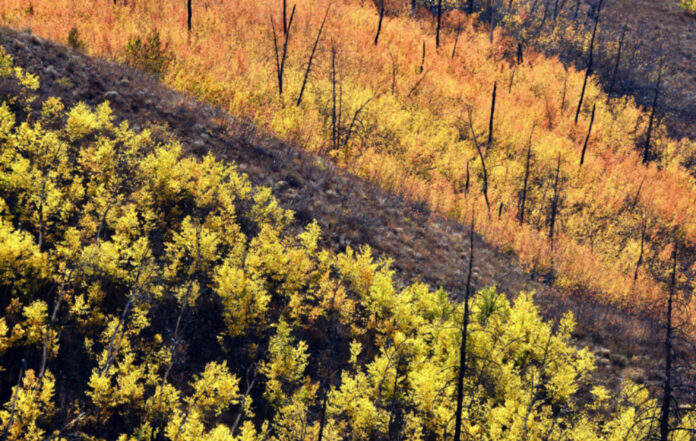By Larry Barnes
We lump aspens into one species, Populus tremuloides, but some are clonal while others reproduce sexually. Some aspen populations are diploid, like you and me (every cell contains two sets of chromosomes, one from mom, the other from dad). But other aspens are triploid; each of their cells has three sets of chromosomes, not two!
In the photo shown here, two genetically distinct aspen clones are living side by side in Greenhorn Gulch; a yellow version in the foreground, its orange cousin in the background. While aspens can produce seeds through ordinary sexual reproduction, they can happily grow in large clonal groves, functioning essentially as a single individual. The trees within the groves, seemingly free agents bearing countless little green leaves that tremble in a summer breeze, are photosynthetic factories whose products actually feed their common motherly tangle of roots beneath the soil. Collectively, they are one living, breathing, genetically distinct individual.
The Pando aspen grove in Utah is one of the largest organisms on Earth, covering 108 acres (~80 football fields) and is made of thousands of trees having the same DNA. The Pando grove may collectively weigh up to 6,600 tons or more than six times the mass of the General Sherman giant sequoia in California. The Pando grove’s root system has been living for 10-16 thousand years, all the while sprouting a succession of trees that usually die before reaching 100.
We tend to think of species as “members of populations that actually or potentially interbreed in nature.” This works much of the time, especially in the animals we are most familiar with. But can a diploid aspen mate with a triploid aspen? How often do two trees from different clones abandon their socialist roots and branch out to actually produce their own pollen and ovules, giving sex a go in the production of bonafide seeds?
The answers to these questions may be known, but many mysteries remain. For example, we look at the aspen in our yard and refer to it as an individual. But maybe it’s part of a larger clone, but still considered an “individual.” We tend to want individuals to exist; perhaps it is part of our Western reductionist mindset. But the gravitas of the individual in nature is greatly overstated. How can we understand the individual when, upon study, “we find it hitched to everything else in the universe,” as John Muir observed?
Dr. Susan Simard from the University of British Columbia has shown the world just how illusionary it is to see a forest as a collection of individuals competing with each other for light, water, and nutrients. In fact, it is truer to see the forest as a “wood wide web” of interactions mediated by fungi in the soil. The fiber optics of the soil is mycorrhizae, a Byzantine tangle of tree rootlets and fungal mycelium through which the forest communicates and shares resources.
Trees of one species feed carbon to trees of other species when there is a surplus for one and a deficit for the other. The tables may turn later when circumstances or season reverses and the former benefactor becomes the beneficiary. Trees drop seeds that become seedlings that struggle in the shade beneath the parent. The mother trees actively help their children, shipping more carbohydrates to them via the mycorrhizae in the soil than they do to unrelated seedlings. Some of the nitrogen in tree tissue can be traced to the ocean, hundreds of miles away, finding its way inland via salmon, who are eaten by bears, who poop in the woods, whose nutrients are parsed out and transported within the mycorrhizae beneath the surface.
We are at the dawn of this new science of relationships that show what First Nations and tribes across the globe have long intuited: we live within a connected world. There are no true individuals.
Larry Barnes retired from 26 years as a biology teacher at Wood River High School and is now transitioning to full-time amateur exploration of the natural world.



